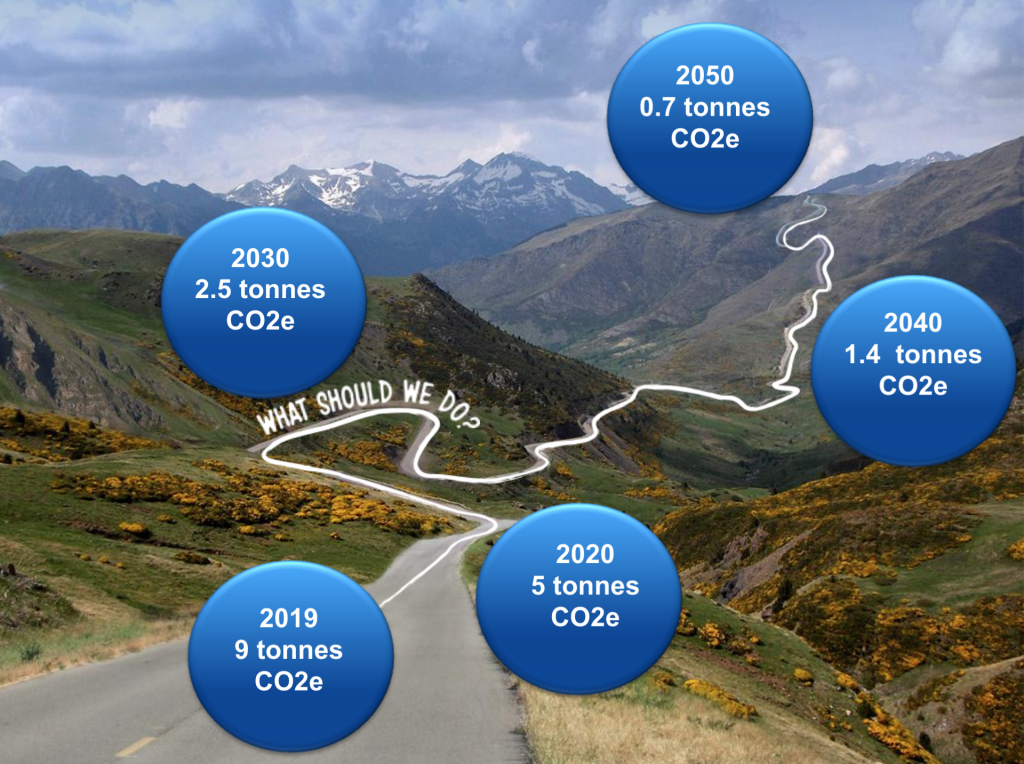What do we have to do to manage the 1.5 degree target and avoid the worst consequences of climate change?

Managing the 1.5 degree target is challenging to say the least, but still reachable if we start doing things differently today from yesterday. According to calculations that we have done based on a few studies, in practice, all of us will have to keep a yearly “carbon dioxide budget” and emit maximally 5 tonnes greenhouse gases by the year 2020 (excluding public consumption). Currently, the average Swede emits nearly 9 tonnes greenhouse gases per year (excluding public consumption). The global average is 6 tonnes greenhouse gases every year.
What is possible to do within a carbon dioxide budget of 5 tonnes?
To create an understanding of what can be included within a carbon dioxide budget of maximally 5 tonnes, here are some general estimates of the emissions of a few activities:
- Driving 10 000 km with a petrol-powered car corresponds to approx. 1 tonne CO2eq emissions.
- Eating non-processed vegan food corresponds to approx. 0.5 tonne and above CO2eq emissions.
- Eating a diet based on a lot of red meat and dairy products corresponds to approx. 2.5 tonnes CO2eq emissions.
- Living in an apartment – electricity, heating and hot water corresponds to approx. 1,5 tonnes CO2eq emissions/apartment (based on Swedish averages with low carbon intensity electricity).
- Living in a house – electricity, heating and hot water equals approx. 2,7 tonnes CO2eq emissions/house (based on Swedish averages with low carbon intensity electricity)
- A 5-hour’ flight corresponds to 1 tonne CO2eq (including high altitude emissions). This means that traveling to and from Frankfurt-New York emits approx. 3 tonnes CO2eq. Traveling to and from London-Mexico corresponds to approx. 4 tonnes CO2eq.
If I offset all my CO2eq emissions – can I emit more than 5 tonnes then?
No. Sorry, but it is not that easy. We have been letting out huge amounts of carbon dioxide for so many years now that we are in a hurry, and we have to do everything that we can to even have a shot at managing the 1.5 degree target. A dream scenario would be if we could reduce our emissions to a maximum of 5 tonnes CO2eq by 2020 and at the same time offset all the emissions that we currently cannot prevent (such as public consumption, to give an example).
So, from where did we get “a maximum of 5 tonnes”?
To begin with, we looked at the study 1.5 degree lifestyles (2018). According to this study, globally, in the year 2030, we will be able to emit maximally 2.5 tonnes CO2eq/person to have a chance of managing the decisive 1.5 degree target. In 2040, we will be able to emit maximally 1.4 tonnes CO2eq/person, and in 2050 – a maximum of only 0.7 tonnes CO2eq/person.
Thereafter, we used the theory of the “Carbon Law” from A roadmap for rapid decarbonisation (Rockström et al, 2017). According to the Carbon Law, we must halve our CO2eq emissions every decade to have a 75% chance at keeping the global temperature below 2 degrees Celcius.
We then combined the results from the two studies, starting with the amount of maximally 2.5 tonnes CO2eq emissions in the year 2030 according to 1.5 degree lifestyles, and doubling this amount according to the Carbon Law to reach the number of a maximum of 5 tonnes CO2eq emissions by 2020. This amount excludes public consumption, however, does not include the justice aspect. Used in for example the Paris Agreement, the justice aspect states that poorer countries should be allowed a longer time to adjust their CO2eq emissions than richer countries. For this reason, we use the wording a maximum of 5 tonnes CO2eq.
So, based on these studies, we would have a pathway to managing the 1.5 degree target if we as soon as possible reduced our CO2eq emission levels to below 5 tonnes and at the same time offset all the emissions that we currently cannot prevent. This way, we would give poorer people in the world a greater chance to better life standards and have a bigger chance at stopping climate change.
1) The numbers from the 1.5 degree lifestyles report do not take into consideration the possibilities that negative emission techniques (NETs) could provide. However, the calculations for the Carbon Law presume NETs to manage the target and keep the global temperature below 2 degrees.
2) Our calculated maximum of 5 tonnes CO2eq emissions per person by 2020 also corresponds with WWF’s goal of 7 tonnes CO2eq emissions per person by 2020 (5 tonnes of CO2eq excluding public consumption).
References
https://www.aalto.fi/department-of-design/15-degrees-lifestyles
https://www.stockholmresilience.org/research/research-news/2017-03-23-curbing-emissions-with-a-new-carbon-law.html
https://www.klimatkalkylatorn.se/downloads/Metoddokument.pdf
https://www.klimatkontot.se/